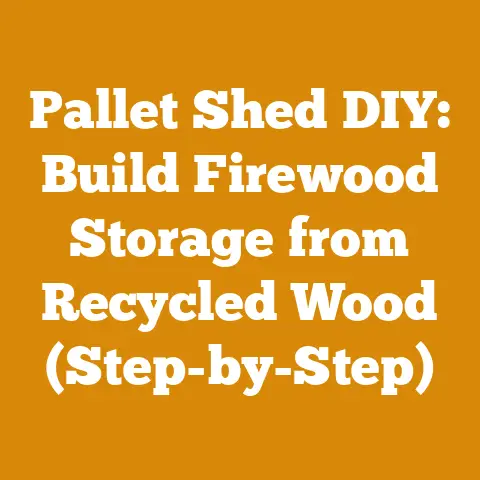The Earth Wood Stove Guide (5 Proven Tips for Efficient Burning)
Do you remember the distinct, comforting aroma of woodsmoke drifting through the air on a crisp winter evening? It’s a scent that evokes feelings of warmth, home, and a connection to something primal. But that experience can be greatly enhanced – or diminished – by how efficiently we burn wood in our stoves. Believe me, I’ve learned this the hard way over the years, from shivering through nights with a poorly performing stove to basking in the efficient heat of a well-managed fire.
The Earth Wood Stove Guide: 5 Proven Tips for Efficient Burning
For decades, I’ve been deeply involved in all aspects of wood processing, from felling trees in the forest to stacking seasoned firewood in my yard. I’ve seen firsthand the difference between a wasteful, smoky fire and one that burns cleanly and efficiently, maximizing heat output and minimizing environmental impact. A properly burned wood stove is not just about warmth; it’s about responsible resource management, reducing emissions, and saving money on fuel. It’s about understanding the nuances of wood, fire, and combustion.
1. Understanding Your Wood: The Foundation of Efficient Burning
Before we even think about lighting a match, we need to understand the fuel we’re about to burn. Wood isn’t just wood; it’s a complex organic material with varying properties that significantly impact its burning characteristics.
Green Wood vs. Seasoned Wood: A Critical Distinction
The most fundamental distinction is between green wood and seasoned wood.
-
Green Wood: This is freshly cut wood that still contains a high moisture content, typically exceeding 50% by weight. Burning green wood is highly inefficient. Much of the fire’s energy is wasted evaporating the water within the wood rather than generating heat. This also leads to incomplete combustion, resulting in excessive smoke, creosote buildup in your chimney, and reduced heat output.
- My Experience: I remember one particularly harsh winter when I was short on seasoned wood and resorted to burning some freshly cut oak. The stove sputtered, the chimney smoked like a factory, and the house remained stubbornly cold. It was a miserable experience that reinforced the importance of proper seasoning.
-
Seasoned Wood: This is wood that has been properly dried, reducing its moisture content to 20% or less. Seasoned wood burns much more efficiently, producing significantly more heat, less smoke, and minimal creosote buildup.
-
Measuring Moisture Content: I use a simple moisture meter to check the moisture content of my firewood. These meters are inexpensive and readily available. Simply insert the probes into a freshly split piece of wood, and the meter will display the moisture percentage. Aim for a reading below 20% for optimal burning.
- Technical Details: The energy required to evaporate water is significant. It takes approximately 970 BTU (British Thermal Units) to convert one pound of water at 212°F (100°C) into steam. That’s a lot of energy that could be going towards heating your home.
Wood Species: Density, Heat Output, and Burning Characteristics
Different wood species have different densities, which directly impacts their heat output and burning characteristics.
-
Hardwoods: These are typically denser than softwoods and contain more energy per unit volume. Examples include oak, maple, birch, ash, and beech. They burn longer, produce more heat, and create fewer sparks.
- Oak: A personal favorite. It’s dense, burns slowly, and produces excellent heat.
- BTU per Cord: Approximately 29 million BTU.
- Maple: Another excellent choice, similar to oak in terms of heat output and burning characteristics.
- BTU per Cord: Approximately 24 million BTU.
- Birch: Burns hot and clean, but it tends to burn faster than oak or maple.
- BTU per Cord: Approximately 20 million BTU.
-
Softwoods: These are less dense than hardwoods and contain less energy per unit volume. Examples include pine, fir, spruce, and cedar. They burn faster, produce more smoke, and are more prone to sparking.
-
Pine: I generally avoid burning pine in my wood stove due to its high resin content, which leads to excessive smoke and creosote buildup. However, it can be useful for kindling due to its easy ignition.
- BTU per Cord: Approximately 15 million BTU.
-
Case Study: Optimizing Wood Selection for a Small Cabin: A friend of mine owned a small cabin in the mountains and relied heavily on a wood stove for heating. He initially burned primarily pine, which was readily available and inexpensive. However, he struggled to keep the cabin warm and had to constantly reload the stove. After switching to a mix of oak and maple, he noticed a significant improvement in heat output and burn time. He also reduced the amount of creosote buildup in his chimney.
- Oak: A personal favorite. It’s dense, burns slowly, and produces excellent heat.
Seasoning Wood: The Art of Drying
Proper seasoning is crucial for efficient burning. The goal is to reduce the moisture content of the wood to 20% or less.
- Stacking: Stack your firewood off the ground on pallets or rails to allow for air circulation. Leave space between the rows to further enhance airflow.
- Location: Choose a sunny, windy location to maximize drying.
- Covering: Cover the top of the stack with a tarp or roof to protect it from rain and snow, but leave the sides open for ventilation.
-
Timing: The seasoning process typically takes 6-12 months, depending on the wood species, climate, and stacking method.
- My Stacking Method: I prefer to stack my firewood in long rows, oriented north-south to maximize sun exposure. I use old railroad ties as a base to keep the wood off the ground and cover the top of the stack with corrugated metal roofing. This method allows for excellent airflow and protects the wood from the elements.
- Data: Studies have shown that properly seasoned wood can produce up to 50% more heat than green wood.
2. Optimizing Your Wood Stove: Preparation for Efficient Combustion
Your wood stove is more than just a metal box; it’s a combustion chamber that needs to be properly maintained and operated for optimal performance.
Cleaning and Maintenance: Ensuring Proper Functionality
Regular cleaning and maintenance are essential for efficient burning and safety.
-
Chimney Sweeping: Have your chimney professionally swept at least once a year, or more frequently if you burn a lot of wood. Creosote buildup is a fire hazard and reduces the efficiency of your stove.
- Creosote Formation: Creosote is a byproduct of incomplete combustion that condenses on the inner walls of your chimney. It’s highly flammable and can cause dangerous chimney fires.
- My Experience: I learned the hard way about the importance of chimney sweeping after experiencing a small chimney fire. It was a terrifying experience that prompted me to become much more diligent about chimney maintenance.
- Inspecting the Stove: Regularly inspect your stove for cracks, leaks, and other damage. Repair any issues promptly to prevent air leaks and ensure proper combustion.
- Gasket Replacement: Replace worn or damaged door and window gaskets to prevent air leaks.
Airflow Control: The Key to Combustion
Controlling airflow is crucial for achieving efficient combustion.
- Primary Air: This is the air that enters the stove at the bottom and fuels the initial combustion of the wood.
- Secondary Air: This is the air that enters the stove above the fire and helps to burn the smoke and gases produced by the primary combustion.
-
Adjusting Airflow: Experiment with different airflow settings to find the optimal balance for your stove and wood type. Generally, you want to start with a high airflow setting to get the fire going and then gradually reduce it as the fire establishes itself.
- Strategic Insight: Understanding how primary and secondary air interact is key to efficient burning. Primary air fuels the initial flame, while secondary air burns off the volatile gases that would otherwise escape as smoke.
Baffle System: Maximizing Heat Transfer
Many modern wood stoves have a baffle system that forces the hot gases to travel a longer path through the stove, maximizing heat transfer to the firebox and increasing efficiency.
- Understanding Baffles: Baffles are designed to slow down the flow of hot gases, allowing more time for heat to be absorbed by the stove’s walls.
- Maintaining Baffles: Regularly inspect and clean your baffles to ensure they are functioning properly.
3. Mastering the Art of Fire Starting: Kindling and Technique
The way you start your fire significantly impacts its efficiency and cleanliness. A well-started fire will burn hotter, cleaner, and longer.
Choosing the Right Kindling: Small and Dry is Key
Kindling is essential for getting a fire started quickly and efficiently.
- Small Pieces: Use small, dry pieces of wood that will ignite easily.
- Softwoods: Softwoods like pine and cedar are excellent choices for kindling due to their easy ignition.
- Dryness: Ensure your kindling is thoroughly dry.
- My Kindling Prep: I collect small branches and twigs from around my property and store them in a dry location. I also split larger pieces of softwood into kindling using a hatchet or knife.
The Top-Down Fire: A Clean-Burning Technique
The top-down fire is a modern technique that promotes clean and efficient burning.
- Layering: Start by placing several large pieces of firewood at the bottom of the stove. Then, layer smaller pieces of wood on top, followed by kindling and a fire starter.
- Ignition: Light the fire starter at the top of the pile.
-
Burning Process: The fire will burn downwards, gradually igniting the larger pieces of wood. This method produces less smoke and creosote than traditional bottom-up fires.
- Data: Studies have shown that top-down fires can reduce smoke emissions by up to 50%.
- Visual Aid: Imagine building a campfire upside down, with the largest logs at the bottom and the kindling at the top.
- My Fire Starting Routine: I use a top-down fire almost exclusively. I find that it’s easier to control, produces less smoke, and burns more efficiently. I use a natural fire starter made from wood shavings and wax to ignite the kindling.
Traditional Bottom-Up Fire: The Classic Approach
The bottom-up fire is a more traditional method that involves placing kindling at the bottom of the stove and gradually adding larger pieces of wood as the fire establishes itself.
- Building the Foundation: Start with a base of crumpled newspaper or other fire starter.
- Adding Kindling: Place small pieces of kindling on top of the fire starter in a teepee or log cabin configuration.
- Gradually Increasing Size: As the kindling ignites, gradually add larger pieces of wood until the fire is established.
4. Maintaining a Hot and Efficient Fire: Fueling the Flames
Once the fire is established, it’s important to maintain a hot and efficient burn by adding fuel strategically.
Adding Fuel: When and How
Adding fuel at the right time and in the right way is crucial for maintaining a hot and efficient fire.
- When to Add Fuel: Add fuel when the fire has burned down to a bed of hot coals but before the flames die out completely.
- How to Add Fuel: Add fuel in a way that doesn’t smother the fire. Place the new pieces of wood on top of the coals, leaving space for air to circulate.
- My Fueling Strategy: I typically add 2-3 pieces of wood at a time, depending on the size of the firebox and the desired heat output. I try to arrange the wood in a way that allows for good airflow around the pieces.
Airflow Adjustment: Fine-Tuning for Optimal Combustion
Adjusting the airflow is essential for maintaining a hot and efficient fire.
- Increasing Airflow: Increase the airflow if the fire is smoldering or producing excessive smoke.
- Decreasing Airflow: Decrease the airflow if the fire is burning too hot or too quickly.
-
Finding the Sweet Spot: The goal is to find the sweet spot where the fire is burning hot and clean without consuming fuel too quickly.
- Technical Insight: The ideal combustion temperature for wood is around 1100°F (600°C). At this temperature, the wood gases are completely burned, minimizing smoke and maximizing heat output.
Monitoring the Fire: Observing the Flames and Smoke
Pay attention to the flames and smoke to monitor the efficiency of your fire.
- Clean Flames: Clean, bright yellow flames indicate efficient combustion.
- Smoky Flames: Smoky, orange flames indicate incomplete combustion.
- Clear Smoke: Clear or minimal smoke indicates efficient combustion.
-
Dark Smoke: Dark, thick smoke indicates incomplete combustion.
- My Observation Technique: I regularly check the smoke coming from my chimney. If I see dark smoke, I know that I need to increase the airflow or add drier wood.
5. Safety First: Protecting Yourself and Your Home
Wood burning can be a safe and efficient way to heat your home, but it’s important to take safety precautions.
Carbon Monoxide Detection: A Silent Killer
Carbon monoxide (CO) is a colorless, odorless gas that can be deadly.
- Install CO Detectors: Install CO detectors on every level of your home, especially near sleeping areas.
- Regular Testing: Test your CO detectors regularly to ensure they are functioning properly.
- Symptoms of CO Poisoning: Be aware of the symptoms of CO poisoning, which include headache, dizziness, nausea, and confusion.
- My Safety Protocol: I have CO detectors installed throughout my home and test them monthly. I also make sure to properly ventilate my home when burning wood.
Chimney Safety: Preventing Fires
Creosote buildup in your chimney can lead to dangerous chimney fires.
- Regular Sweeping: Have your chimney professionally swept at least once a year.
- Inspecting the Chimney: Regularly inspect your chimney for cracks, leaks, and other damage.
- Clearance to Combustibles: Ensure that your chimney has proper clearance to combustible materials, such as wood framing and insulation.
Fire Extinguishers: Be Prepared
Keep a fire extinguisher readily available in case of a fire.
- Type of Extinguisher: Use a Class A fire extinguisher for wood fires.
- Proper Training: Familiarize yourself with how to use a fire extinguisher.
- My Fire Safety Measures: I keep a fire extinguisher near my wood stove and have a fire blanket readily available. I also have a plan for evacuating my home in case of a fire.
Safe Ash Disposal: Preventing Spontaneous Combustion
Ashes can contain embers that can remain hot for several days.
- Metal Container: Store ashes in a metal container with a tight-fitting lid.
- Safe Location: Place the container on a non-combustible surface away from your home and other structures.
- Waiting Period: Allow the ashes to cool completely before disposing of them.
- My Ash Disposal Method: I store my ashes in a metal container with a lid and place it on a concrete slab away from my house. I let the ashes cool for at least a week before disposing of them.
Chainsaw Safety: A Critical Skill
Whether harvesting your own firewood or processing logs, chainsaw safety is paramount.
- Proper Training: Take a chainsaw safety course before operating a chainsaw.
- Personal Protective Equipment (PPE): Always wear appropriate PPE, including a helmet, eye protection, hearing protection, chainsaw chaps, and gloves.
- Chainsaw Maintenance: Regularly maintain your chainsaw, including sharpening the chain, checking the chain tension, and lubricating the bar.
-
Safe Felling Techniques: Learn safe felling techniques to avoid injury and damage to property.
- My Chainsaw Setup: I use a Stihl MS 261 C-M chainsaw with a 18-inch bar. I find that it’s a versatile saw that’s suitable for a wide range of tasks. I always wear a helmet, eye protection, hearing protection, chainsaw chaps, and gloves when operating my chainsaw.
- Felling Technique Case Study: On a project clearing a small wooded lot, I encountered several trees with a significant lean. By carefully assessing the lean and using appropriate felling techniques, I was able to safely fell the trees without any incidents. This involved using a felling wedge to control the direction of the fall and making precise cuts to avoid barber chairing.
Implementing these five proven tips will not only enhance the efficiency of your wood-burning experience but also contribute to a safer and more environmentally responsible approach to heating your home. It’s a journey of learning and refinement, and I encourage you to experiment and adapt these techniques to your specific needs and circumstances.
Now that you’ve equipped yourself with this knowledge, I encourage you to take the next step. Inspect your wood stove, assess your firewood supply, and start implementing these techniques. Remember, efficient wood burning is a continuous process of learning and improvement. Embrace the challenge, and enjoy the warmth and satisfaction of a well-managed fire.






